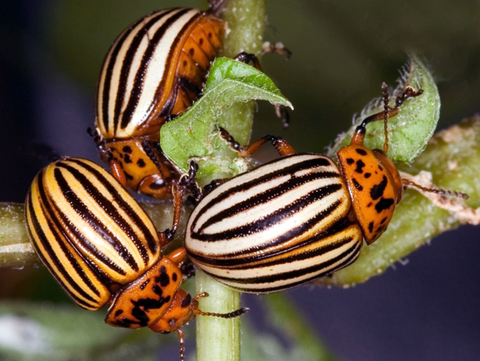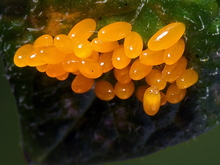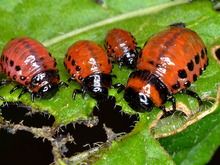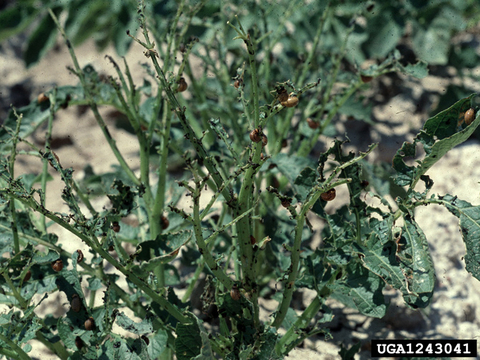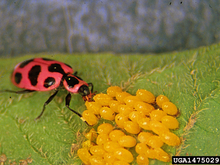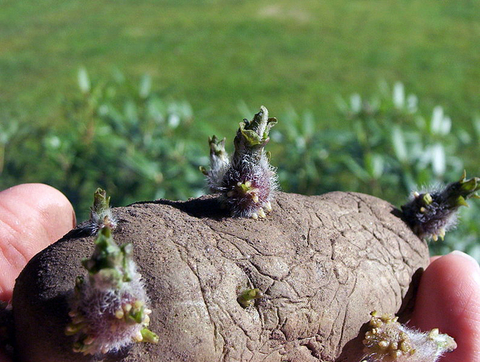Quick facts
- The Colorado potato beetle (Leptinotarsa decemlineata) is a major potato pest throughout North America. It can also feed on eggplant, tomatillo and related crops.
- Adults become active in spring, about the same time potato plants emerge from the ground.
- Larvae and adults feed on leaves and can completely defoliate plants.
- Many pesticides are ineffective because of the pesticide resistance of the Colorado potato beetle.
- A combination of pest management tactics can reduce Colorado potato beetle numbers.
How to identify Colorado potato beetles
Adults
- Beetles are oval and 3/8 inch long.
- Have a yellow-orange prothorax (the area behind the head) and yellowish-white wing covers with 10 narrow black stripes.
- Females lay clusters of bright yellowish-orange oval eggs on the underside of leaves.
Larvae
- When young larvae first hatch, they are brick red with black heads.
- Older larvae are pink to salmon colored with black heads.
- All larvae have two rows of dark spots on each side of their bodies.
Biology of Colorado potato beetle
- Colorado potato beetle adults spend the winter 5-10 inches underground in potato fields, field margins, windbreaks and gardens.
- Adults feed for a short time in the spring and then begin to mate and lay clusters of 10-30 eggs on the undersides of leaves.
- Each female can lay up to 350 eggs during her adult life which can last several weeks.
- Eggs begin to hatch within 2 weeks, depending upon temperatures.
- Larvae cluster near the egg mass when young but begin to move throughout the plant as they eat the leaves.
- Larvae can complete development within 10 days if average temperatures are in the mid-80s F while it can take over a month if temperatures average near 60 F.
- The fourth instar larvae drop from the plant, burrow into the soil and transform into pupae.
- In southern and central Minnesota there is generally a second generation. By midsummer, all stages of Colorado potato beetles, eggs, larvae and adults can be present in one area.
Damage
- Old larvae (the last or 4th larval instar) are responsible for as much as 75% of feeding damage.
- Potatoes can usually tolerate up to 30% defoliation before flowering.
- They are much more sensitive when tubers are beginning to size up and can only tolerate about 10% defoliation.
- Tuber bulking begins soon after flowering, making this time critical for beetle management.
Managing Colorado potato beetles in home gardens
Treatment of Colorado potato beetles in home gardens can be challenging. Use a combination of different pest management tactics to reduce Colorado potato beetle numbers.
Once you have Colorado potato beetles in your growing space, they will always be around. A key part of management is keeping an eye on their populations and damage so that you can intervene when damage is becoming too much for your plants to handle.
Potatoes can tolerate up to 30% defoliation before flowering but only 10% at the onset of tuber initiation. A key time to spot beetles is when the adults first start emerging in the spring.
Make your garden less welcoming to Colorado potato beetle
- When Colorado potato beetles first emerge in the spring, they will look for potatoes and other plants they like to feed on.
- Clean up weeds like nightshade and ground cherry near your garden, as these weeds can act as a possible food source.
- Mulch between plants can make it harder for Colorado potato beetle to complete its lifecycle.
- Clean up your planting at the end of the year to make it harder for adults to overwinter.
Plant early to avoid high beetle populations
- Plant an early maturing variety to escape much of the damage caused by adults emerging in midsummer.
- Check seed catalogs for varieties that mature in less than 80 days.
- Yields on early maturing varieties are not as large, and often these varieties do not store as well as longer day varieties (for example, Russet Burbank)
Reduce local populations of Colorado potato beetle by taking a year off
- Colorado potato beetle can’t move very far, especially before temperatures reach 70°F. If you have no potatoes in your garden for a year, you can reduce their numbers.
- This is most effective if potatoes are being grown within a radius of ¼ to ½ mile away, and the summer weather is mild.
Handpicking in small gardens can be effective. It is especially effective if you catch the adults coming out of their winter hiding spots.
- Drop adults and larvae in a pail filled with soapy water.
- Remove or crush the yellowish-orange eggs on the underside of leaves.
- New adult beetles can fly into gardens so be sure to check your potatoes regularly.
- Handpicking may be less practical in larger gardens.
Row cover can be placed over your potato rows to prevent Colorado potato beetle from feeding and laying eggs on plants. It is effective if you place it before you see any beetles, and if you are putting your plants in a different spot than last year. You should remove it when temperatures and humidity increase, as it will promote plant disease.
There are a few natural enemies of Colorado potato beetles, but they may have little impact on overall Colorado potato beetle numbers.
- Stink bugs and lady beetles will prey upon Colorado potato beetle eggs.
- The fungus Beauveria bassiana will kill both larvae and adults. Products containing this fungus are still being researched.
Managing Colorado potato beetle on farms
- Potatoes can tolerate up to 30% defoliation before flowering but only 10% at the onset of tuber initiation.
- Check 50 plants every 3-4 days, and consider treatment if you are seeing 10% defoliation.
- Note the life stages and sizes of larvae you are seeing, as this can impact which management actions will be most effective.
Rotation
- Research suggests keeping a distance of at least 1/4 mile from the previous year’s infested field can help in reducing early season infestations from emerging adults.
Short season varieties
- Plant an early maturing variety to escape much of the damage caused by adults emerging in midsummer.
- Check seed catalogs for varieties that mature in less than 80 days.
- Yields on early maturing varieties are not as large, and often these varieties do not store as well as longer-day varieties (for example, Russet Burbank).
Green sprouting (or chitting)
Green sprouting is the process of promoting sprouting in seed potatoes before planting. When planted, these seed potatoes emerge quicker, and produce a dense canopy quickly. Yields may be higher as there are more tubers per plant, but these tubers tend to be small.
- Expose seed potatoes to conditions that induce sprouting (40-50% relative humidity, diffuse light, 55-60 degrees F).
- The length of time varies; many growers do this for 2-12 weeks. The longer the seed potatoes are in these conditions, the more they will age physiologically.
- The longer they are left in sprouting-inducing conditions, the more the sprouting process progresses (to a point; after around 10 weeks other problems can occur).
- Some evidence suggests that later maturing cultivars need to be chitted for a longer period than early maturing cultivars to see a response. As a basic guide, potatoes should be cut, healed, and planted when the sprouts turn green (or in some cases purple).
Row covers
- Row covers can be placed over your potato rows to prevent Colorado potato beetle from feeding and laying eggs on plants.
- Put row covers in place before you see any beetles, and make sure you are rotating.
- You should remove row covers when temperatures and humidity increase, as it will promote plant disease.
Trenches
Trenches are a good option to experiment with if you have a tractor and hilling equipment.
- Trenches substitute physical distance for a physical barrier that overwinter beetles can’t get around and beetles either fall into it (and get trapped) or just avoid it altogether.
- Trenches should be set up at least one week before adult potato beetles start to emerge.
- Dig trenches two feet deep and six to 24 inches wide, with sides that angle between 65 and 90 degrees.
- A Minnesota trial had success with a trench made with two passes of discs in both directions.
- Line the trench with plastic mulch (you may need landscape staples to pin plastic to the bottom of the trench).
- When temperatures warm, beetles can fly, so it may not provide season-long control.
Straw mulches
- In 2020 Minnesota trials, a thick straw mulch reduced beetle numbers and helped suppress annual weeds.
- Apply mulch at a time when you’ve been able to do at least one cultivation pass for weed control.
- Straw won’t control perennial weeds.
Handpicking
- For small plots, handpicking can be effective, especially if done early in the season when adults are emerging after the winter.
- Adults and larvae can be put in a bucket of soapy water.
- Squish eggs.
Other approaches
In Minnesota on-farm trials in 2020, it was found that eggplant trap crops and flaming did not help reduce Colorado potato beetle numbers.
There are a few natural enemies of Colorado potato beetles, but they may have little impact on overall Colorado potato beetle numbers.
- Stink bugs and lady beetles will prey upon Colorado potato beetle eggs.
- The fungus Beauveria bassiana will kill both larvae and adults. Products containing this fungus are still being researched.
- Foliar materials are best applied between 15 and 30% egg hatch for best control.
- Insecticides do not work on the egg or pupae stage.
- Adults are not particularly susceptible to insecticides.
- Larvae are easiest to control when they are young, larger larvae are harder to control.
Managing resistance
Colorado potato beetle can quickly develop resistance to pesticides and has documented resistance to over 50 different active ingredients from all major insecticide groups.
Growers need to rotate products and chemistries. Once growers find themselves increasing the rate to control Colorado potato beetle, it is likely resistance is evolving. Do not use the same pesticide on overwintering adults and their larvae that you use on adults later in the summer or the next spring.
Organic options
Entrust (spinosad) resistance is present on some farms. Bt and neem oil can be effective but need to be used when larvae are small and before populations are high.
Conventional options
- If growing in an area with a history of Colorado potato beetle, consider using a systemic insecticide to the seed or soil at planting, or to foliage shortly after emergence.
- If populations tend to be lower, foliar treatment alone can work.
- If planting close to last year’s potatoes, invasion may be concentrated on one side of the field, and just treating this hotspot can work.
Note that many products available for Colorado Potato Beetle are restricted-use products and will require a certified pesticide applicator license.
See the Midwest Vegetable Production Guide for a list of current conventional and organic recommended products.
CAUTION: Mention of a pesticide or use of a pesticide label is for educational purposes only. Always follow the pesticide label directions attached to the pesticide container you are using. Be sure that the plant you wish to treat is listed on the label of the pesticide you intend to use. And observe the number of days between pesticide application and when you can harvest your crop. Remember, the label is the law.
Reviewed in 2024


